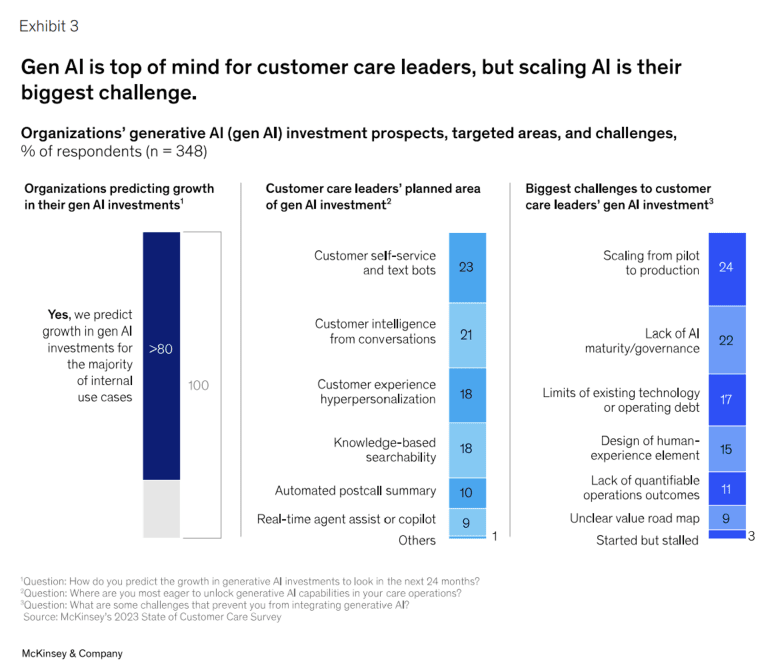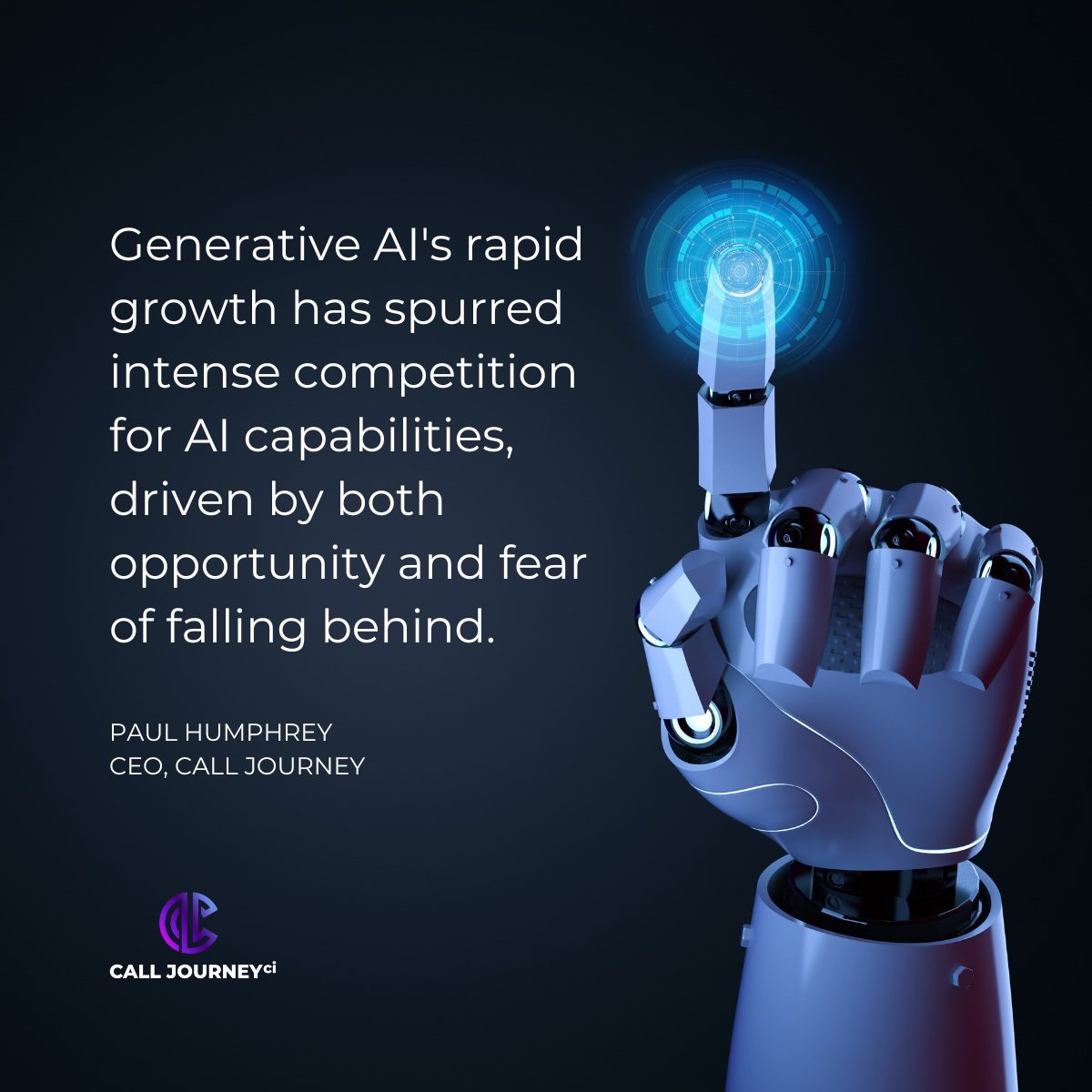A consolidated view from over 100 transformation initiatives observations across multiple world geographies
As a Company and as the CEO of a global company whose roots have been seeded and grown though utilization of Artificial Intelligence (AI), we have had a front seat view of how AI has transformed organizations; from enhancing efficiency and productivity, to fueling improved customer experience, to being a key element of driving data-driven decision making, AI has been the cornerstone of our SaaS solution.
We have been at the forefront of the explosion of digital data and improvements in algorithms, especially deep learning, and we’ve harnessed these advancements in the way our solution is crafted. Add to that significant acceleration in capabilities in areas like NLP/NLU and Machine Learning, we have seen a massive adoption and utilization of AI firsthand across our customer and partner eco systems over the last three to five years.
So the expansion now and acceleration of focus on AI with the explosion of Generative AI in the last 18 months, organizations are scrambling to harness the new capability both because of genuinely wanting to drive significant benefit that AI can deliver, but also from fear of being left behind as adoption accelerates.
I’ve been fortunate as an AI-based SaaS company CEO to be exposed to significant volumes of customer transformation innovation across our global footprint both via our extensive and high impact channel/partner environment and directly with those customers looking to harness, transform and innovate with AI and specifically GenAI.
...the expansion now and acceleration of focus on AI with the explosion of Generative AI in the last 18 months, organizations are scrambling to harness the new capability both because of genuinely wanting to drive significant benefit that AI can deliver, but also from fear of being left behind as adoption accelerates.
Paul Humphrey, CEO
Many of our partners and customers have asked myself and our team for advice as they embark on these AI-fueled transformation journeys.
So I have embarked on a mini project to share and download my/our observations in order to help organization embarking on or already down the path of AI driven CX Transformation. In order to make this worthwhile, I will break the observations into themes/categories to help compartmentalize the insights.
Following are some insights, observations and recommendations from our/my experience in well over a hundred transformation initiatives during the last couple of years and working with some of the world best leaders and organizations in this space. The majority of these transformation initiatives have been Customer Experience (CX) transformation focused, so these observations are bias to AI fueled CX Transformation.
1. Be AI future ready within your organizational eco system
There have been a huge number of global studies showing the high failure rate of GenAI projects and we’ve seen it firsthand too. Some of the challenges that we’ve seen first-hand have been;
• Lack of Clarity on Outcome/Goal
With CX Leaders environments now statistically being more complex than ever, our observation has been that multiple competing high priorities are likely to cause either unclear goals/outcomes or a lack of precise focus on an initiative, this is usually aligned to an ambiguous use case.
Pick a use case and drive at it with clarity of goal and purpose.
Paul Humphrey, CEO
• Not focusing on core fundamentals first and foremost – remember data is your best friend.
It’s hugely common to see organizations with disparate data sets and environments. A common view of a customer and their journey is crucial to success. We also often see a lack of data democratization, one of the most common fatal flaws in CX transformation activities. Becoming “data driven” is fast becoming the North Star for most organizations but challenges like data silo’s, cross-organization business silo’s and a lack of company-infused data intelligence in their DNA, often hampers CX AI Transformation initiatives. Our observations are that this shouldn’t mean organizations need to hire droves of data scientists, it means that they should create an environment of data citizens and support and prioritize data driven decisions. We’ve seen this work best when these elements are present:
- Lead from the top – senior Business leaders need to “trust but verify” when making decisions. Ask what data supports the idea, initiative or recommendation
- Create Data portals/platforms that are easily accessible – employees need to be able to access data, insights, and intelligence to support their decision-making process.
- Focus on creating data that has a “bias to action” – to help with making data easy to consume for employees, there should always be a bias to delivering data that doesn’t need to be wrangled or where the employee needs to have a data science degree. Focus on delivering data in a way that is easily understood and interpreted, show insights, and move even toward recommendations in data frameworks.
- Be a data storyteller – we all like stories and most learn and embrace insights through storytelling. Make sure your data tells a story.
• Running before you walk in AI adoption
We have observed many trends where organizations have dived in head first into customer facing GenAI initiatives like customer interaction automation with various bot platforms and solutions. More often than not, the innovative hasn’t sourced true lived experience data to inform the AI driven Bot interaction strategy in the first place. Understanding where to prioritize such interactions should always be data driven (quantitative and qualitative).
Best practice outcomes based on our observations and reviews are when organizations utilize Gen-AI for analytics and intelligence first, rather than a customer-facing service. Focus your “experimentation” internally first
Paul Humphrey, CEO

• Not observing cost control caution
With AI now a strategic imperative, and organizations charging head first into AI capabilities such as leveraging large language models (LLMs) and other generative AI, LLM “suppliers” are still chipping away at their commercial models – often to the detriment of their end users. These models are complex, have huge data workloads which equals expensive “experimentation” and commercialization.
We are seeing organizations lean into LLM partnerships or leveraging companies who have already done the trial and error based heavy lifting and learning.
Recently, in a published article on AI impacts on CTO’s and CFO’s they estimated a total cost of ownership (TCO) across 3 different LLM archetypes:
- Taker—using off-the-shelf models, with little or no customization: $2 million
- Maker—building and training your own foundational model: $200 million
- Shaper—customizing models to integrate with internal data and systems: $10 million
Deciding on how on organizations will address the opportunities that LLM’s deliver is crucial.
Paul Humphrey, CEO
• Having both a lack of “context awareness” and lived experience insights when leveraging foundational customer intelligence.
In well over 90% of initiatives that have labored speed to realization, moreover than not the core issue lies in the type of data that drives decision making and direction. When focus on CX Transformation, the data that is most commonly sources to steer and inform the initiative is customer intelligence-based data. And, because much of this data is typically driven by Marketing (no offense marketing), most of those insights come from these types of sources:
- Surveys (that can be conducted online, in person or via email)
- Feedback forms (where brands ask customers to rate their satisfaction levels)
- Monitoring online reviews and ratings (sites such as Google Reviews, G2 and other third-party review platforms)
- Social media (customer sentiment and general brand perception)
- Customer Interviews (often in “one-to-one” discussions)
Our/my observations are that these customer intelligence sources often deliver skewed data and insights, they lack context awareness, and lose the additional value derived from mining actual volume-based lived experience insights that come from everyday interactions. Every second, minute, hour and day that a customer is interacting with an organization, they are leaving valuable nuggets of intelligence. Leaning into just analyzing structured data-based interactions like chat, email and social interactions often lack context and tend to miss valuable inflection and context that come from voice interactions (human to human).
The common theme of successful AI-driven CX transformation initiatives is where the intelligence and customer data is harmonized and homogenized – but where there is a higher bias focus to context aware intelligence that is derived from human-to-human interactions.
Prioritizing context-aware intelligence is imperative – mine actual human-to-human voice interactions for the richest and most accurate source of customer, operations, and employee intelligence as the foundation for CX transformation initiatives. Voice of the customer – now with voice!
Paul Humphrey, CEO

About the Author
Paul Humphrey, Call Journey CEO
Paul Humphrey, co-founded Call Journey along with Anthony Karam around four years ago and has been the CEO of the organization since then. He is a serial growth accelerator with a long history of creating and building high performance teams and communities with an insatiable appetite for customer centricity.






